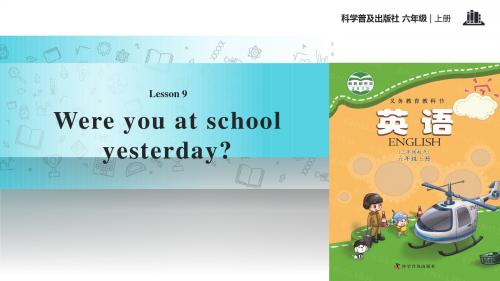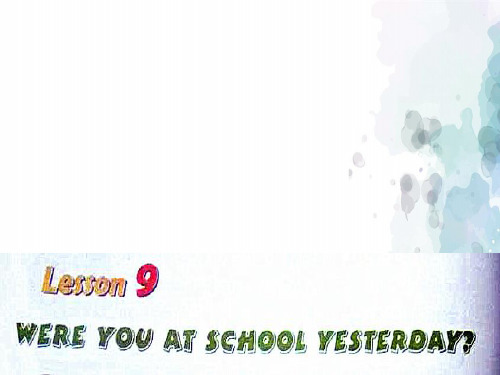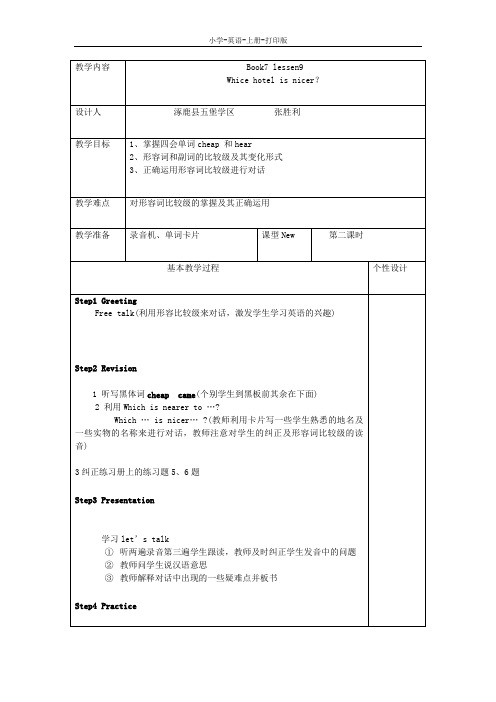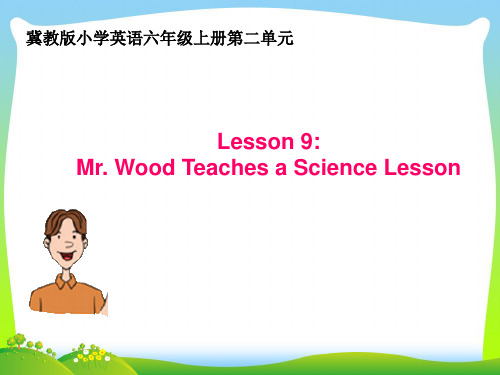科普小学英语六年级上第九课
- 格式:ppt
- 大小:2.24 MB
- 文档页数:5



六年级上册英语第9课Unit 9: A Trip to the CountrysideIn this article, we will explore the content and objectives of the ninth lesson in the sixth-grade English textbook, titled "A Trip to the Countryside." This lesson focuses on vocabulary related to the countryside, prepositions of place, and developing reading comprehension skills. By the end of this lesson, students will be able to describe the countryside, understand the main ideas of a text, and use prepositions correctly in sentences.The lesson begins with a warm-up activity to activate students' prior knowledge about the countryside. The teacher can ask questions such as "Have you ever been to the countryside? What do you see there?" to encourage students to share their experiences. This activity serves as a pre-reading exercise and creates a context for the upcoming reading passage.After the warm-up, the teacher introduces new vocabulary words related to the countryside, such as fields, mountains, rivers, and farms. The students practice the pronunciation and spelling of these words through various interactive activities, including word puzzles, flashcards, and group discussions. This vocabulary expansion aims to enhance the students' ability to describe different aspects of the countryside accurately.Next, the teacher introduces prepositions of place, such as in, on, and under, through visual aids and real-life examples. Students learn the correct usage of these prepositions to describe the position of objects in relation to the countryside. They engage in exercises to reinforce their understanding, such as filling in the blanks with the appropriate prepositions or matching the prepositions to the corresponding pictures.Once the vocabulary and prepositions are introduced, the focus shifts to reading comprehension. The students read a short passage about a family's trip to the countryside. They practice reading aloud, identify the main ideas, and answer comprehension questions to gauge their understanding. This activity promotes the development ofreading skills, including understanding the main idea, recognizing details, and making inferences.To further enhance their comprehension skills, the students engage in a pair or group activity called "Find the Hidden Details." In this activity, each group receives a different picture related to the countryside, such as a landscape or a farm scene. The students take turns describing their pictures to their group members, who must listen carefully and identify the hidden details mentioned. This activity promotes active listening, attention to detail, and effective communication skills.In the final segment of the lesson, the students participate in a speaking activity called "Planning a Countryside Trip." They work in pairs or small groups to plan a hypothetical trip to the countryside. Each group member takes turns suggesting places to visit, activities to do, and transportation to use. They use the vocabulary and prepositions learned throughout the lesson to express their ideas and negotiate with their peers. This activity encourages creativity, collaboration, and the application of newly acquired language skills.In conclusion, the ninth lesson of the sixth-grade English textbook, titled "A Trip to the Countryside," focuses on vocabulary expansion, prepositions of place, and reading comprehension. Through a series of interactive activities, the students learn to describe the countryside, understand the main ideas of a text, and use prepositions accurately. By the end of the lesson, students will be equipped with the necessary language skills to describe the countryside, understand written texts, and engage in meaningful conversations related to planning a countryside trip.。


六年级上册英语第九课的课文Here is the English essay for the topic "The text of Unit 9, Grade 6 English Textbook":The text of Unit 9, Grade 6 English Textbook is an engaging and informative piece that covers a range of topics related to different types of jobs and professions. The lesson aims to introduce students to the diverse range of career options available and the unique skills and responsibilities associated with various occupations.The passage begins by highlighting the importance of work in our lives and how it shapes our daily routines and experiences. It emphasizes that work not only provides us with the means to support ourselves financially but also offers a sense of purpose, fulfillment, and personal growth. The text then delves into the various types of jobs and professions, from traditional occupations like doctors, teachers, and engineers to more specialized and emerging fields like computer programmers, social workers, and environmental scientists.One of the key aspects of the text is the focus on the specific skills and qualifications required for different jobs. For instance, thepassage discusses the extensive medical training and expertise needed to become a doctor, the strong communication and interpersonal skills required for a career in teaching, and the analytical and problem-solving abilities necessary for an engineering profession. This information is valuable for students as they begin to consider their own career paths and the steps they need to take to achieve their professional goals.Furthermore, the text highlights the unique challenges and responsibilities associated with different occupations. It explores the high-pressure environments and life-or-death decisions faced by doctors, the patience and adaptability required for teachers to effectively manage diverse classrooms, and the critical thinking and attention to detail demanded of engineers in designing and constructing complex infrastructures. By exposing students to these nuances, the lesson helps them develop a more comprehensive understanding of the realities and demands of various professions.One of the strengths of the text is its ability to provide a balanced perspective on the pros and cons of different jobs. While it emphasizes the rewarding aspects of various occupations, such as the sense of accomplishment, the opportunity to make a positive impact on society, and the potential for career advancement, it also acknowledges the potential stresses, challenges, and sacrifices that come with certain professions. This balanced approach encouragesstudents to carefully consider the tradeoffs and make informed decisions about their future career paths.Moreover, the text is structured in a way that makes it easy for students to grasp and retain the key information. It provides clear and concise explanations of the different jobs and their associated responsibilities, complemented by engaging examples and relevant statistics. The use of relatable language and the inclusion of real-life anecdotes further enhance the accessibility and relevance of the content for the target audience.In conclusion, the text of Unit 9, Grade 6 English Textbook is a comprehensive and informative resource that effectively introduces students to the diverse world of jobs and professions. By highlighting the unique skills, responsibilities, and challenges associated with various occupations, the lesson empowers students to make more informed decisions about their future career paths and develop a deeper appreciation for the diverse roles that contribute to the functioning of our society.。

科普版-英语-六年级上册-Lesson9全课时教案Lesson 9 Which hotel is nicer?第一课时(Learn new words let’s learn)一、学习目标:Learn new words let’s learn二、教学目标:1、掌握四会单词cheap 和hear2、形容词和副词的比较级及其变化形式三、教学难点1.字母组合ea在单词中的读音2.形容词和副词比较级的构成及其变化形式3.简单学习一些短语如:get on 等的用法和汉语意思四、词汇沙龙Cheap 的反义词___________ 那个旅馆___________Happy的副词___________ 在这附近___________等待___________ the other___________ jump onto ___________五、课堂导引Step 1.GreetingFree talkStep 2. Revision1,听写三个单词pass、young、hair(三个学生到黑板前其余在下面)2, 利用卡片学习hotel、cheap、happily、guard、leave、hear、quickly jump onto worry came 的读音及其汉语意思(因为集中识词中学生已会读并知道汉语意思所以本课学生只需熟练并巩固通过集体读单个读等多种方式使每位学生会读)Step 3.Presentation1,板书学习cheap hear guard came 四词(因前两词需要四会所以再次提出)①看音标学读音guard came(分解式学读音有利于学生复习直呼式学读音及闭音标单词的发音方法)②利用字母拼读法识记cheap 和hear如:c-h-e-a-p cheap(要求眼看、手写、脑想、口读) 2学习let’s learn 和ask and answer 小黑板板书形容词比较级的变化形式①一般情况下,直接加er如near-nearer②以不发音的字母e结尾加如:nice-nicer③以一个辅音字母结尾的重读闭音节词双写该辅音字母加er如big-biger fat-fatter④以辅音字母加y结尾的形容词先把y 变为I再加er如heavy-heavier听录音注意HongKong Macao的读音学生跟读两遍教师纠正Step 4.Practice①学习let’s learn听两遍录音学生跟读教师个别纠正读音中的错误②把全班分成两组然后变换多种方式进行问答直到灵活熟练为止,注意nearer的读音③同样练习Ask and answerStep 5 Summary①总结小黑板上的重点知识,学生做笔记并识记②做练习册中的第5题、第6题③准备利用形容比较级nearer等进行对话板书设计:Lesson 9 Which hotel is nicer?guard (火车的)管理员came come的过去式cheap c-h-e-a-phear h-e-a-r六、巩固练习Ⅰ补全单词H r (听见) le e(离开;出发)J p (跳)happ y(愉快地)W ry(担忧)to(到……之上)Ⅱ写出下列单词的比较级Near------ ()fast ------ ()Good ------()cheap------ ()Safe ------ ()clean------ ()Small------ ()big ------ ()Ⅲ单项选择1、Are there any________ near here?A. hotelB. hotelsC. an2、One is big ._______is smallA.AnotherB. OtherC.The other3、_______ is nearer ,the bigger one_______ the smaller one ?A.Which; orB. What; andC.Where ;or4、--thank you very much.--_______A.Thank you tooB. You’re welcomeC.Ok5、Excuse me. Are there_______ chairs in your room?A. someB. aC. any第二课时(Let′s talk )一、学习目标:Let′s talk二、教学目标1、掌握四会单词cheap 和hear2、形容词和副词的比较级及其变化形式3、正确运用形容词比较级进行对话三、教学难点对形容词比较级的掌握及其正确运用四、课堂导引Step1 GreetingFree talk(利用形容比较级来对话,激发学生学习英语的兴趣)Step2 Revision1 听写黑体词cheap came(个别学生到黑板前其余在下面)2 利用Which is nearer to …?Which …is nicer…?(教师利用卡片写一些学生熟悉的地名及一些实物的名称来进行对话,教师注意对学生的纠正及形容词比较级的读音)3纠正练习册上的练习题5、6题Step3 Presentation学习l et’s talk①听两遍录音第三遍学生跟读,教师及时纠正学生发音中的问题②教师问学生说汉语意思③教师解释对话中出现的一些疑难点并板书Step4 Practice①教师读学生跟读个别学生领读直到全部会读为止②学生分成组与组之间、行与行之间、两人之间读、熟读③表演对话④背诵⑤学习let’s chant(听一遍录音教师领读一遍然后解释汉语意思学生读三遍左右注意韵律) Step5 Summary①背诵let’s talk②抄写两遍let’s talk翻译一遍板书设计lesson 9any用在疑问和否定句中one the other仅限两者中的一个和另一个cheaperbiggercheaner中er的读音五、重点讲解形容词的比较等级形容词有三个等级:原级,比较级和最高级形容词的比较等级的规则变化:形容词比较等级的不规则变化:(3) 形容词比较等级的用法:原级:肯定结构:as+形容词原形+as 表“和…一样” 例子: Jimmy is as tall as Tony. 否定结构:not 形容词so(as) +原形+as 表“不如…”例子: Jimmy is as tall as Tony.比较级结构: 形容词比较级+than 表“比…更…” 例子: T ony is taller than Jimmy.最高级结构:the+形容词最高级+比较范围表“最…” 例子:Peter is the youngest in the class.六、巩固练习Ⅰ按要求写词语1.strong(反义词)_____2.tall(反义词)_____3.sad(反义词)_____4.small(反义词)_____5.heavy (比较级)_____6.fast (比较级)_____7.good (比较级)_____8.strong (比较级)_____9.good (最高级)______ 10.smaller (原级)_____ Ⅱ选择:1.The smaller one is _____ than the bigger one.A. cheapB. cheaperC. cheapest 2.Which is _____ to Shenzhen, Hong Kong or Macao?A. nearB. nearerC. nearest 3.Look at the two old man, which one is_____?A. heavyB. heavyerC. heavier 4.Whose train is this, the _____ man or the _____ man ?A. fat, thinB. fater, thinerC.fatter, thinner 5.The giraffe is _____ than the elephant.A. much tallB. much tallerC. many tall6.Which cake is _____, the big one or the small one?A. niceB. nicerC.niceer7.Look! I can dance _____ than you .A. goodB. gooderC. better8.It is one of the _____ buildings in China.A. tallB. tallerC. tallest9.The Jinmao Tower is 420 meters _____.A. tallB. tallerC. high10.I am much _____ and _____ than _____ else.A. hot, big, everythingB. hoter, biger, everythingC.hotter, bigger, everything第三课时( Read)一、学习目标:Read二、教学目标:1、通过熟读促语感形成,提高背的能力和质量1、形容词和副词的比较级及其变化形式2、能够正确熟练运用形容词的比较级三、教学难点形容词的比较级及变化形式四、课堂导引Step1 GreetingFree talk(运用形容词的比较级进行对话,要求学生尽量都会用nicer bigger 等来进行对话) Step2 Revision1 检查的let’s talk 的背诵情况2 复习本课学过的单词(利用卡片来复习可以节省时间,还能提高学生的注意力)Step3 Presentation1 学习Read Missing the train2 板书第一幅简笔画听录音,学生复述教师解释wait for,one is …, The other的用法及其汉语意思3.依次类推,注意短语come into ,get on ,begin tojump onto等汉语意思4.6幅简笔画下面加注关键词Step4 Practice1 熟读第一幅简笔画内容直到学生能根据关键词复述为止2依次类推,学生若有困难可适当降低难度,语法正确能说出关键句子即可。